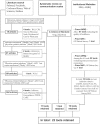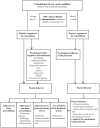A scale assessing doctor-patient communication in a context of acute conditions based on a systematic review
- PMID: 29466407
- PMCID: PMC5821327
- DOI: 10.1371/journal.pone.0192306
A scale assessing doctor-patient communication in a context of acute conditions based on a systematic review
Abstract
Background: There is no validated generic tool to measure Doctor-Patient-Communication (DPC) in a context of acute conditions.
Objective: To create and validate such a scale in a real population.
Materials and method: We performed a systematic review of validated DPC scales available in English. From these, using a theoretical model based on a multidisciplinary approach, we selected pertinent items that met the inclusion criteria and included them in a simple questionnaire. This tool based on a synthesis of the literature was then validated in a prospective study in two hospital emergency departments.
Results: We found 22 pertinent questionnaires and scoring systems. From these, we extracted items and built a scale based on 15 questions with graded responses (Likert from 1 to 4). The mean time for questionnaire completion was 3 minutes. We included 189 adults and adolescents in the study and analyzed complete responses to the questionnaire by 149 patients, gathered over the phone one week after their consultation. The scale had high internal consistency (Cronbach's alpha = 0.89) and good external validity. Two questions were removed due to redundancy giving a scale based on 13 questions.
Conclusions: We have created an easy-to-use and validated generic questionnaire to assess DPC in a context of acute conditions, usable both in clinical research and in routine practice.
Conflict of interest statement
Figures
References
-
- Richard C, Lussier MT. [Professional communication in Health]. 2nd editionSaint-Laurent, Quebec, Canada: Editions du Renouveau pedagogique; 2016.
-
- Beck RS, Daughtridge R, Sloane PD. Physician-patient communication in the primary care office: a systematic review. J Am Board Fam Pract. 2002;15(1):25–38. - PubMed
-
- Fossli J, Dahl FA, Safran DG, Garratt AM, Krupat E, Finset A, Gulbrandsen P. The ability of a behaviour-specific patient questionnaire to identify poorly performing doctors. BMJ Qual Saf. 2011: 20 (10): 885–93.Ogden J, Moatti JP. [Health Psychology] Bruxelles: De Boeck; 2008. doi: 10.1136/bmjqs-2011-000021 - DOI - PubMed
-
- Makoul G. Essential elements of communication in medical encounters: the Kalamazoo consensus statement. Acad Med 2001;76:390–3. - PubMed
Publication types
MeSH terms
LinkOut - more resources
Full Text Sources
Other Literature Sources
Medical
Miscellaneous





